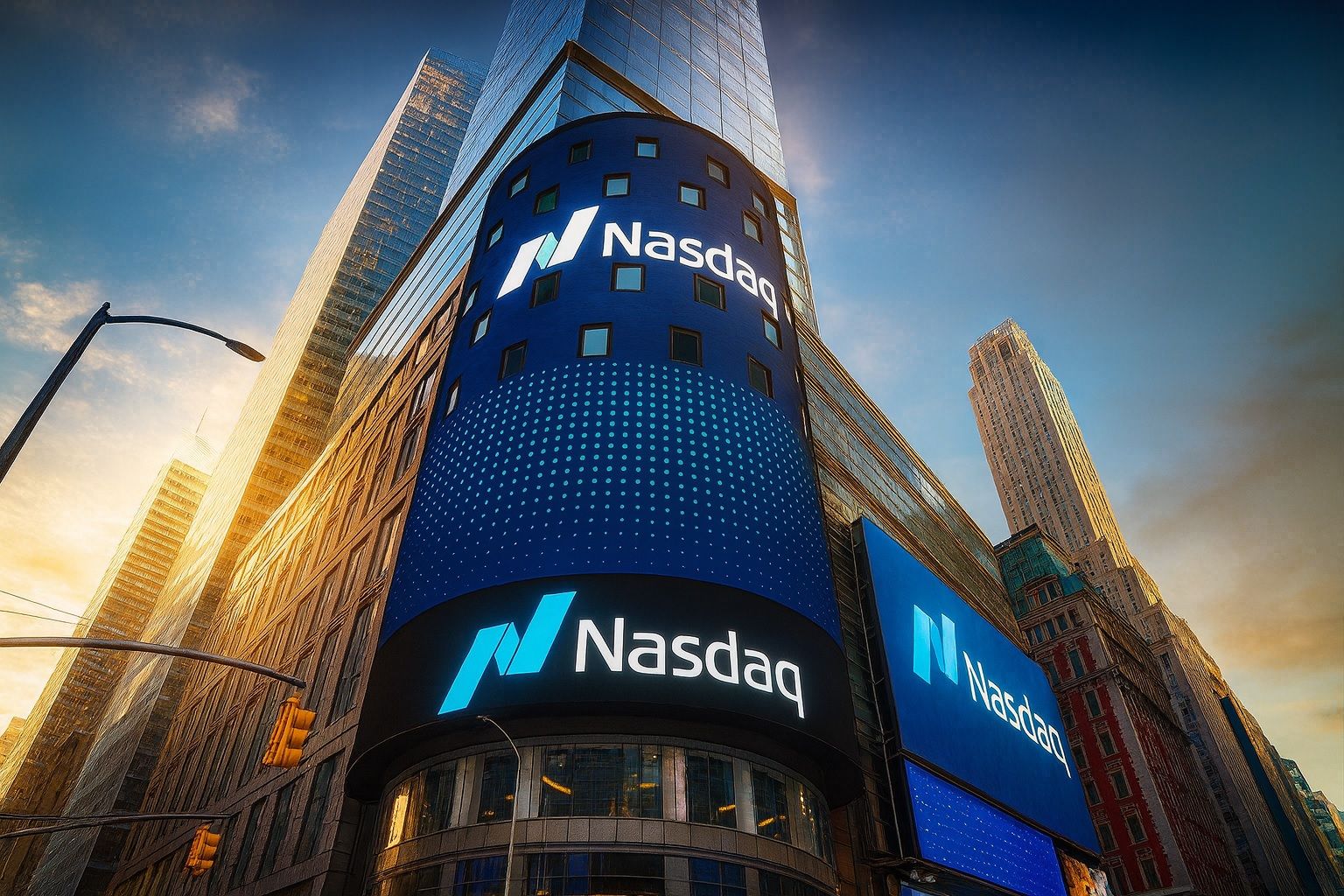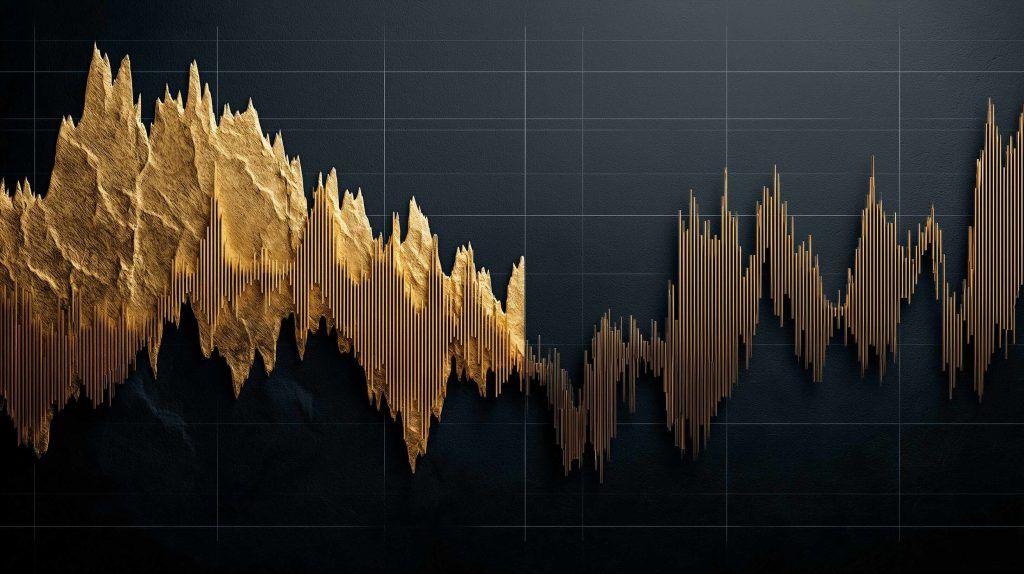- Wall Street at Peak Levels: The S&P 500 and Nasdaq surged to all-time highs on Oct. 8, 2025, with the S&P closing at 6,753.72 (+0.6% that day) and Nasdaq at 23,043.38 (+1.1%) [1]. Major indices have climbed ~15–18% year-to-date, reflecting robust investor enthusiasm [2]. A brief pullback after a 7-day winning streak was quickly erased by dip-buyers, keeping the uptrend intact [3].
- Tech & AI Stocks Fueling the Rally: High-growth tech names have skyrocketed in 2025, riding an AI boom. For example, AMD spiked ~24% in one day after unveiling a blockbuster AI chip deal with OpenAI [4]. Other big winners include Nvidia (+41% YTD), Oracle (+73%), and Palantir (+143%) amid AI hype [5]. These outsized gains powered the S&P and Nasdaq higher, though some profit-taking emerged mid-week on valuation jitters [6]. “Momentum is on the side of investors over the last few days,” noted one strategist, as rate-cut hopes and tech euphoria keep bulls in control.
- Safe Havens Surge Alongside Stocks: In an unusual twist, gold prices have rallied with equities – a sign of hedging under the surface. Gold breached $4,000/oz for the first time ever on Oct. 8 (intraday ~$4,078) [7], up ~53% YTD (vastly outpacing stocks) [8]. Although it pulled back slightly, gold is still hovering near $4,000 as of Oct. 10 [9]. Investors have piled into precious metals as “insurance” against risks like high debt, inflation, and geopolitical strife [10]. Bond yields have eased with rising Fed rate-cut bets (10-year Treasury ~4.1% vs ~4.5% a month ago) [11], and oil prices have softened to about $61 per barrel – trends that usually support stocks. The fact that stocks and gold are rallying in tandem underscores a divided mindset: many are confidently taking risk on one hand while also hedging with safe-havens on the other [12].
- Fed Policy Pivot Drives Optimism – and Caution: A major pillar of the rally is the Federal Reserve’s shift to easing. The Fed delivered its first 2025 rate cut in late September, and minutes from the Fed’s October meeting (released this week) show most officials support further cuts this year amid cooling labor markets [13]. Futures markets are pricing in a ~95% chance of another 0.25% cut at the Oct. 28–29 meeting [14]. This dovish outlook has buoyed equities. However, the Fed minutes also revealed “lingering inflation concerns” among many policymakers [15]. Fed Chair Jerome Powell is walking a tightrope: any hint of renewed hawkishness or prioritizing inflation over growth could spook markets that are banking on easy money [16]. “Central bankers are still paying lip service to their inflation mandates,” one analyst warns – suggesting the Fed might talk tougher on inflation even as it cuts rates [17]. In short, investors expect relief from the Fed, but inflation surprises or a hawkish tone remain a key risk to this record rally [18].
- Dow Jones at a Technical Pivot Point: The Dow Jones Industrial Average (and its ETF, DIA) has been hovering near record territory but underperformed slightly in recent days. On Thursday (Oct. 9), the Dow slid 0.52% (versus the S&P’s –0.28%) amid late-week profit-taking. Technical indicators show the Dow at a crossroads: pivot resistance for the SPDR Dow Jones ETF stands around $465.14 and pivot support at $460.97. Traders view a breakout above ~$465 as bullish, while a drop below ~$461 would be bearish. With DIA trading roughly in the low-$460s, sentiment is essentially neutral across short-, mid-, and long-term horizons – a classic wait-and-see stance. No clear trend signal has been identified, and analysts note elevated downside risk given that the next major support level on the charts lies considerably lower (long-term support around $443). In practical terms, the Dow is range-bound near its peak: a decisive move either way (perhaps triggered by earnings or news) could set the tone for the next leg. One set of AI-driven trading models suggests that if DIA climbs above its upper pivot (~$465), it could run up to the high-$460s in the near term, whereas failure to break out might see a pullback toward the mid-$440s. This pivot point neatly symbolizes the broader market dynamic – poised between continued euphoria and a potential correction.
- Political & Global Wildcards: The backdrop is complicated by political turmoil and global events. The U.S. government shutdown is now in its 10th day (since Oct. 1) with budget negotiations at an impasse. Thus far, markets have mostly shrugged off the shutdown – viewing it as familiar Washington theater with limited economic impact if resolved soon [19]. “The market generally looks past government shutdowns because they don’t usually have longer-term negative impact on the economy,” explains one investment strategist. However, the shutdown has created a data drought: key economic reports (jobs, CPI, etc.) have been delayed, leaving investors “flying blind” on the latest fundamentals [20]. On the international front, geopolitics remain a double-edged sword. This week brought a hopeful sign as Israel and Hamas reached a tentative ceasefire deal (including hostage releases), which President Trump hailed as the “first steps toward…Everlasting Peace” in Gaza. The de-escalation of that conflict removes a source of market anxiety [21]. Conversely, tensions with China simmer – President Trump reportedly is weighing new tariff hikes and sees “no reason” to meet with China’s Xi at an upcoming summit (a stance that rattled some investors). In short, any major geopolitical flare-up or protracted U.S. political dysfunction could quickly test market confidence, even as the current rally has weathered these issues so far.
- SPY Performance & Outlook: The SPDR S&P 500 ETF (SPY) – a broad market proxy – is up about 15% in 2025 (as of Oct. 9), roughly matching the index’s gain. It has risen ~1% in the past week alone amid the October run-up. Wall Street analysts remain guardedly optimistic on further upside. According to TipRanks’ aggregated ETF data, SPY carries a “Moderate Buy” consensus rating, and the average price target of ~$737 implies roughly 10% upside from recent levels. In other words, even after this year’s big rally, analysts see the S&P reaching higher into 2026. Bulls argue that cooling inflation, upcoming Fed rate cuts, and resilient corporate earnings can keep the party going into next year [22] [23]. Indeed, the market’s breadth has improved at times – sectors like healthcare and financials have had spurts of strength on favorable news, suggesting the rally is not entirely reliant on tech giants. However, valuation concerns are creeping in. The S&P 500’s forward price/earnings ratio has stretched well above historical norms thanks to surging tech prices. Even some tech insiders are sounding alarms: Amazon founder Jeff Bezos cautioned that the AI sector may be in an “industrial bubble” phase where it’s hard to separate true winners from hype [24]. Likewise, the Bank of England warned this week that equity valuations – “particularly for technology companies focused on AI” – look excessively high and could face a “sudden correction” if rosy assumptions falter [25]. In the near term, the upcoming Q3 earnings season (kicking off with major bank results on Oct. 13) and economic reports (like consumer sentiment on Oct. 10) will be critical tests. Strong earnings and outlooks could validate the rally, while any disappointments or hot inflation prints might reinforce those caution flags.
Analysis & Forecast: Inflection Point Ahead?
The 2025 stock market rally has been nothing short of historic – a potent mix of AI-driven exuberance, hopes of monetary easing, and TINA (there is no alternative) mentality pushing equities and even gold to record highs. As of early October, investor sentiment remains predominantly bullish, and the path of least resistance has been upward. As one market observer noted, despite a “slew of potential headwinds… the market’s mood remains remarkably bullish” – with many assuming that political dramas and global conflicts will resolve without lasting harm [26]. So far, that optimism has paid off handsomely: “Investors who have held their nerve are cleaning up” even as the “drums of worry are banging louder each day,” as an investment director at AJ Bell put it [27].
Can the rally continue? In the near term, there are reasons to think it might. The Federal Reserve appears poised to deliver another rate cut by the end of October, providing further liquidity and a lower discount rate – a tailwind for stocks [28]. Historically, when the Fed eases and the economy avoids recession, equities often grind higher. Moreover, there are signs that economic data (once the shutdown-induced blackout ends) could support a “Goldilocks” narrative: cooling inflation with decent growth. Unemployment remains low, and if inflation readings for September (CPI, etc.) come in benign once released, it would bolster the case for the Fed to keep trimming rates. Corporate earnings will also drive the next phase. Thus far, early reporters like PepsiCo and Delta Air Lines have topped expectations and offered upbeat forecasts [29], hinting that consumer demand is holding up. If the bulk of S&P 500 companies can show mid-to-high single digit earnings growth and stable margins, it would affirm current valuations – or even justify some further upside. In that best-case scenario, the S&P 500 could indeed approach the Street’s ~740 target (about 10% higher) over the coming months, especially if AI-related revenues continue to surprise to the upside and other sectors pick up steam.
However, the risks of a pullback are growing in tandem with the market’s heights. The technical “pivot point” in the Dow around 36,000 (DIA ~$465) is a clear marker of this inflection – a break one way or the other could signal a broader momentum shift. Some cracks in leadership have already emerged: the beloved “Magnificent Seven” mega-cap tech stocks have seen a few stumbles (e.g. Oracle’s 6% drop on cloud growth fears, Tesla’s choppiness around product announcements). Market breadth remains a concern; until recently, a huge portion of 2025’s gains came from the top handful of tech companies. If those leaders falter, and if investors don’t rotate into other sectors, the indexes could quickly lose altitude. Valuation overhang is another worry – as noted, authorities like the BoE and prominent investors have warned that parts of the market, especially AI-related stocks, may be in bubble territory [30] [31]. It wouldn’t take much to trigger a sentiment reversal: for instance, a hawkish surprise from Powell (e.g. hinting that inflation’s resurgence could pause rate cuts) or an exogenous shock.
On the latter front, exogenous risks cannot be ignored. The Middle East peace progress is encouraging, but the world is far from tranquil. Any re-escalation of conflict (in Ukraine, Gaza, or a new flashpoint) could send oil and commodity prices spiking and sapping risk appetite. In the U.S., if the government shutdown drags on or bleeds into a debt ceiling standoff, economic damage could accumulate and unnerve investors. Additionally, the bond market’s calm could prove temporary – should inflation data come in hotter than expected once reports resume, bond yields could jump back up, undermining stock valuations (recall that much of 2025’s rally has coincided with the 10-year yield sliding from ~4.5% to ~4.1% [32]).
Market experts are divided on how long the party will last. Some argue that as long as the Fed is easing and a recession is averted, stocks could continue their climb through year-end. Others emphasize that “waves don’t go on forever; it will eventually crest and decline,” as the cycle of greed and fear inevitably turns [33]. The prudent approach, as voiced by many strategists now, is cautious optimism: participate in the rally but keep an eye on the exits. Diversification and hedges (like a dash of gold – which has proven its worth as a hedge this year) can help balance the risk of a sudden downturn.
In summary, the U.S. stock market of October 2025 finds itself at a pivotal juncture – both figuratively and literally. The bull case still has legs: cooling inflation, imminent Fed rate cuts, robust innovation (AI), and resilient corporate earnings could propel stocks to even higher records in the coming months. On the other hand, the bear case is gaining subtle momentum: stretched valuations, technical fatigue near record highs, and underpriced risks (whether from policy mistakes or geopolitical surprises) could materialize and bring a sharp correction. The SPDR Dow Jones ETF’s pivot range of ~$461–$465 neatly encapsulates this balance of forces. As one technical analyst noted, full alignment in neutral sentiment favors a wait-and-see stance – the market may churn sideways until a clear catalyst tips the scales.
Investors would be wise to stay nimble and informed. In the coming days, keep a close watch on Fed communications (Powell’s commentary), key data releases (inflation, consumer sentiment), and the early wave of earnings. Those inputs will likely determine whether this remarkable 2025 rally powers ahead into a year-end melt-up – or finally hits a wall and reverses course. At this crossroads, the only certainty is volatility. As the saying goes, markets take the stairs up and the elevator down; after climbing to record heights, it’s more important than ever for market participants to have a handle on the risks even as they reach for further rewards. The next few weeks could set the tone for 2026: a continuation of the bull run, or the start of a long-anticipated reality check. Smart money is watching those pivot points – both the numeric levels on the charts and the figurative pivots in policy and sentiment – to navigate whatever comes next in this extraordinary market chapter.
Sources:
- Tech Space 2.0 (TS2) – Powell’s Next Move Could Make or Break 2025’s Record Stock Rally [34] [35] [36] [37]
- Tech Space 2.0 – Record Highs, AI Hype, and a Shutdown: Key Takeaways… [38]
- TS2 – Stock Market Today: Wall Street Rally Stalls, Tech Slumps as Gold Hits $4,000
- TS2 – Stocks Soar to Record Highs, Gold Tops $4,000 – Historic Rally [39] [40] [41]
- TipRanks – SPY ETF News (Oct 9, 2025) (performance and analyst outlook)
- TipRanks/The Fly – DIA Pivot Points (technical pivot levels for Dow ETF)
- StockTraders Daily – DIA Price Dynamics (Oct 10, 2025) (neutral sentiment, support/resistance signals)
- TipRanks – Stock Market News Review (Oct 9, 2025) (market closing stats, S&P –0.28%, Nasdaq –0.15%, Dow –0.52%)
- TipRanks – Stock Market News Today (Oct 10, 2025) (futures and market context, yields, commodities)
- Reuters – Market and economic insights as cited by TS2 (shutdown effects, peace deal, BoE warning) [42] [43].
References
1. ts2.tech, 2. ts2.tech, 3. ts2.tech, 4. ts2.tech, 5. ts2.tech, 6. ts2.tech, 7. ts2.tech, 8. ts2.tech, 9. ts2.tech, 10. ts2.tech, 11. ts2.tech, 12. ts2.tech, 13. ts2.tech, 14. ts2.tech, 15. ts2.tech, 16. ts2.tech, 17. ts2.tech, 18. ts2.tech, 19. ts2.tech, 20. ts2.tech, 21. ts2.tech, 22. ts2.tech, 23. ts2.tech, 24. ts2.tech, 25. ts2.tech, 26. ts2.tech, 27. ts2.tech, 28. ts2.tech, 29. ts2.tech, 30. ts2.tech, 31. ts2.tech, 32. ts2.tech, 33. ts2.tech, 34. ts2.tech, 35. ts2.tech, 36. ts2.tech, 37. ts2.tech, 38. ts2.tech, 39. ts2.tech, 40. ts2.tech, 41. ts2.tech, 42. ts2.tech, 43. ts2.tech







